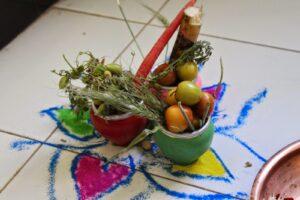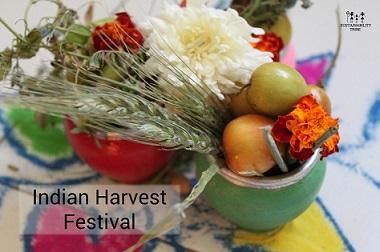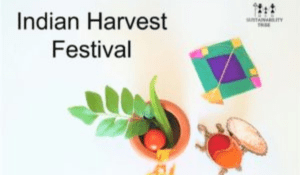Hello Tribe, wishing you all a very happy, healthy, and prosperous new year! While the rest of the world re-start their business in the full swing after Christmas and new year holidays; India, the country of many cultures and many festivals starts its new year with harvest festivals in January. Indian Harvest Festival, known as Makar Sankranti in the state of Maharashtra, Uttarayan in Gujrat, Lohri in the state of Punjab, Pongal in Tamil Nadu, and Bhogali Bihu in Assam. They are celebrated differently with different regional names in different parts of India but the reason behind the celebration is the same; celebrating a new harvest!
I call this Indian festival a traditional sustainable lifestyle festival because this festival is focused on worshipping food, eating healthy, fresh food, and wellness; right at the start of the new year! Almost like making a new year’s resolution of clean eating! Read our healthy and sustainable eating guide here.
Generally, 14th Jan celebrates the transition of the Sun into the zodiac sign of Makara Rashi (Capricorn) on its celestial path. The day is also believed to mark the arrival of spring in India and is the only festival in India that falls on the same date in the Gregorian calendar, almost every year. Makara Sankranti commemorates the beginning of the harvest season and cessation of the northeast monsoon in South India.

Worshipping harvest in earthen wears, Sugad Poojan
Til Gul & Kites
In western India, the celebration of this day consists of a few rituals and traditions.
In the morning married ladies offer prayers and perform Sugad Pujan where they worship small earthen wares which hold small portions of new harvest like wheat springs, carrot, sugar cane, chickpea springs, Indian Jujube, etc. These earthen pots are then shared with other ladies after pooja. This signifies prosperity, sharing, and happiness. Sweets made of sesame seeds and jaggery are distributed among each other to mark a change in food habits and intake of nourishing and rich food in winter. While exchanging these sweets as tokens of goodwill people greet each other with the words, Accept this til-gul and utter sweet words.
During the day kids and most of the families fly beautiful and colorful kites. The act stands as a metaphor for reaching their beloved God. Kites are always the most fun part of this festival and many kids get a grant from their parents to stay on the terrace the whole day to fly kites 🙂

Kite flying
Sankranti Traditions
During the evenings, married women come together in a social gathering for the Haldi Kumkum ceremony. In this ceremony, they exchange Haldi (turmeric) and Kumkum (vermilion powder), as a symbol of their married status and wishing for their husbands’ long lives. The Haldi Kumkum ceremony is celebrated on many occasions throughout the year however the specialty of Makar Sankranti Haldi Kukmkum is to also give gifts of ‘Sankrant vans’.

Ladies in Maharastra wear quintessential black sarees. It is a tradition to celebrate the first Sankranti of newlywed and newborn babies with some added enthusiasm. The newlywed woman is gifted a black saree and sugar jewelry (halvyache dagine). Here is me wearing sugary jewelry at the first harvest festival after my wedding.
There is a special ceremony of ‘Bornhan’ (shower with berries) for kids up to 5 years old, generally celebrated along with Haldi Kumkum. This is more of a fun ceremony to be celebrated with other kids. The child is dressed in black clothes with sugary jewelry and literally showered with Ber or Indian Jujube.
During my childhood, I remember my mother used to visit the nearby temple with decorated earthen pots and exchange them with other ladies after the pooja. We kids used to spend the entire day on the terrace flying kites. In the evenings, we used to get dressed and visit the neighborhood with friends distributing Til-Gul. Sometimes I used to go with my mother for the Haldi Kumkum ceremony. And when my mother used to host the ceremony at our home, I used to get busy helping her decorate the home, inviting guests, and even taking part in the Haldi Kumkum ceremony.

Alternative Ways of Celebrating Harvest Festival in Urban Spaces:
It’s been more than 14 years, I am living an expatriate life, in a totally different natural and social environment. But does that mean I can’t celebrate the festivals, which are such a big part of my childhood? Not really, so I celebrate these traditional festivals with a modern and meaningful twist. Especially as a mother, I want my son to understand the cultural, social, and environmental significance of festivals like these. So here are some alternative ways I celebrate Harvest Festival or Makar Sankranti.
- Visiting an organic farm and picking our own vegetables. One of the years, we visited an organic farm in Abu Dhabi with our son and spent quite a few hours getting out hands dirty, learning about how food grows. In the evening I prepared a special meal out of all the ingredients we harvested on the farm. Read here our experience on a farm in UAE.

I grow edible vegetables and herbs in my balcony garden. So I pick fresh harvest from my balcony garden for or Sankranti Sugad Pujan. Here are some tips on growing food in the container garden.

- Whenever I host the Sankranti Haldi Kumkum ceremony, I make sure to choose some sustainable gifts for my guests. As it is a harvest festival, it’s much more appropriate to gift plants, seeds, and homemade compost, here are tips for making compost at home.
- Last year, during the same time I was taking some pottery on wheel classes. So I went one step further ahead and made my own decorate earthen pot or ‘Sugad’ for Sankranti Poojan, harvested fresh food from my garden.
Through such an outside-the-box celebration, I don’t just connect with my roots but can make my son understand the true meaning and significance behind these festivals and traditions. This is critical more than any other time when the old traditions are re-surfacing in the society but more for ‘consumption’ (like fashion, items, shopping, etc) than for its true meaning.
Hope you enjoyed reading about this festival and its traditions. But most importantly Harvest festival signifies the efforts of our farmers and understanding of real food. The slow food is grown at the right time & season by using a natural process. When climate change has become such a critical topic, we all need to reject industrial food and opt for real for our health and our planet’s health. Read here an informative article about Sustainable food. You can also join our ‘Food Ambassadorship‘ program and become our Ambassador.
Here is wishing you all a happy Harvest Festival and remember to eat healthy and fresh food!

If you are new to Sustainability Tribe, join our tribe here!

